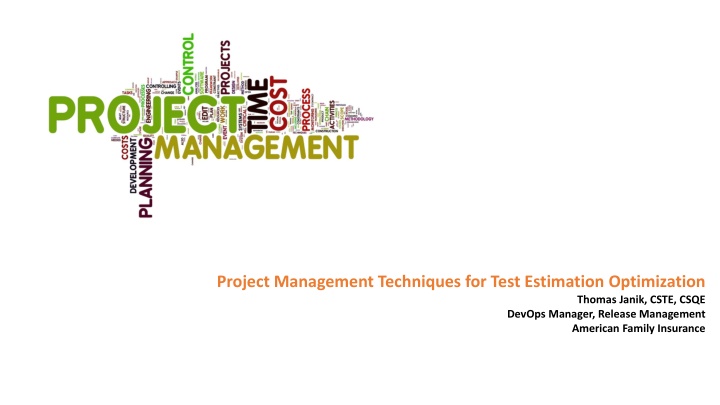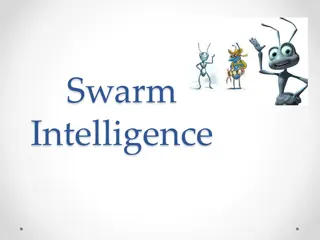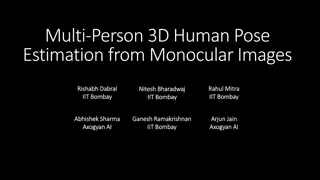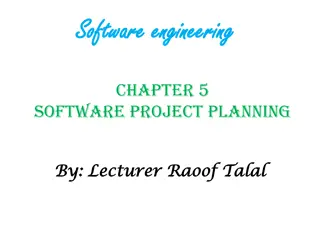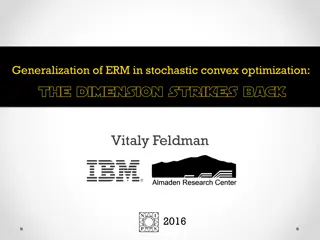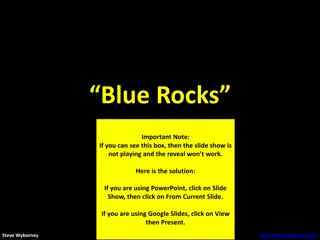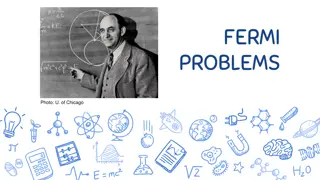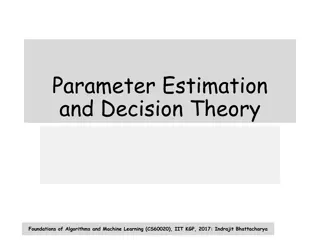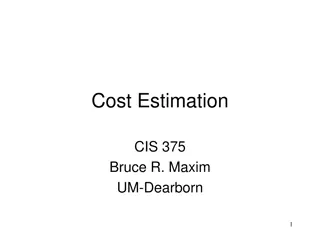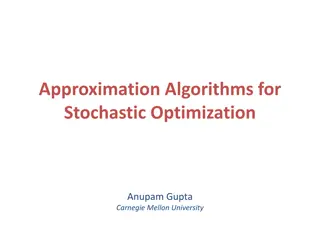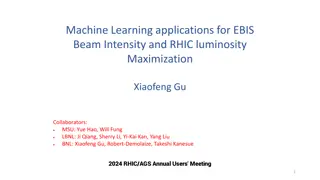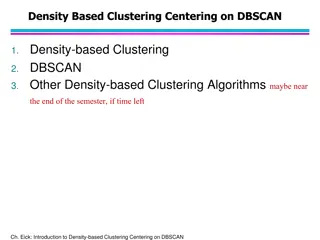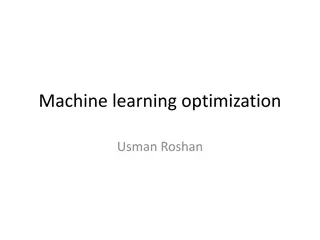Project Management Techniques for Test Estimation Optimization
Explore test estimation techniques such as Work Breakdown Structure (WBS), Triple Constraint Estimation, Kaizen Events, Function/Testing Point Analysis Method, and Use Case Point/Test Case Point Method. Learn how to classify, weigh, and estimate effort for testing projects effectively.
Download Presentation

Please find below an Image/Link to download the presentation.
The content on the website is provided AS IS for your information and personal use only. It may not be sold, licensed, or shared on other websites without obtaining consent from the author.If you encounter any issues during the download, it is possible that the publisher has removed the file from their server.
You are allowed to download the files provided on this website for personal or commercial use, subject to the condition that they are used lawfully. All files are the property of their respective owners.
The content on the website is provided AS IS for your information and personal use only. It may not be sold, licensed, or shared on other websites without obtaining consent from the author.
E N D
Presentation Transcript
Project Management Techniques for Test Estimation Optimization Thomas Janik, CSTE, CSQE DevOps Manager, Release Management American Family Insurance
Project Management Techniques for Test Estimation Optimization Project Management Techniques for Test Estimation Optimization Session Agenda: Familiar/Common Test Estimating Techniques What is a Work Breakdown Structure (WBS)? What does DONE mean? Triple Constraint Estimation Kaizen Events
Test Estimation: Test Estimation:
Test Estimation: Function / Testing Point Analysis Method Test Estimation: Function / Testing Point Analysis Method Decide on an effort classification / weight Divide your application into function points Classify / weigh each function point Multiply the weight by the function point for the estimate
Test Estimation: Function / Testing Point Analysis Method Test Estimation: Function / Testing Point Analysis Method
Test Estimation: Function / Testing Point Analysis Method Test Estimation: Function / Testing Point Analysis Method Advantages: Can be generated in early project stages Can be generated from requirements specifications Simple math Disadvantages: No variables for unknowns Accurate only if continually updated If no requirements exist, estimation must come from ideation
Test Estimation: Test Estimation: Use Use Case Point / Test Case Point Method Case Point / Test Case Point Method Unadjusted actor weights = total number of actors (positive, negative, and exceptional) Unadjusted use case weight = total number of use cases Use case point = actor weights + use case weight Determine EF (Environmental Factor or use .5) Adjusted use case point = use case point * [0.65+ (0.01 * EF] Estimate = adjusted use case point * CF (Conversion Factor) Or estimate duration/number of executions of each test case
Test Estimation: Test Estimation: Use Use Case Point / Test Case Case Point / Test Case Method Method
Test Estimation: Test Estimation: Use Use Case Point / Test Case Case Point / Test Case Method Method Advantages: Multiple weighting factors for better accuracy Experts not needed Very fast Disadvantages: Requires a significant amount of system knowledge Requires requirements (or test case) completeness first Coefficients have to be adjusted Not so simple math
Test Estimation: Development Percentage Method Test Estimation: Development Percentage Method Get development estimates Use a generic % of development for an initial test estimate Define complexity multiplier Multiply complexity multiplier by initial test estimate
Test Estimation: Development Percentage Method Test Estimation: Development Percentage Method Advantages: Popular / widely used (circa 1996) Can be incorporated with function points for accuracy Simple math Disadvantages: Not provable via scientific methods No different than ad-hoc estimation with a complexity factor
Test Estimation: Experience Best Guess / Ad Test Estimation: Experience Best Guess / Ad- -hoc Methods hoc Methods Last time it took 2 months I think it will be done in 2 weeks Just test until the release date (or end of sprint) Everyone knows all testing takes 27% of project time Don t estimate just tell them we ll be done when we re done
Test Estimation: Experience Best Guess / Ad Test Estimation: Experience Best Guess / Ad- -hoc Methods hoc Methods
Test Estimation: Experience Best Guess / Ad Test Estimation: Experience Best Guess / Ad- -hoc Methods hoc Methods Advantages: Super easy just guess (no math!) Instant estimate People tend to think it s accurate because of previous experience Disadvantages: Sets project up for missed deadlines In reality there is minimal accuracy sans ESP
How Can Project Management Techniques Help? How Can Project Management Techniques Help?
Work Breakdown Structure Work Breakdown Structure Can be the basis for almost all modern test estimation methods Impossible to estimate anything as a whole Must understand what DONE looks like (activity later) Break down functionality into smaller units Subdivide smaller units (wash, rinse, repeat) Continue to subdivide until all units are able to be estimated It s broken down enough when you can confidently estimate it
Level 1 Notepad Edit frame Level 2 Menus Level 3 File Edit
Level 2 Menus Status Bar Level 3 File Edit Format View Help Word Wrap View Help New Undo About Notepad Open Cut Font Level 4 Save Copy Save As Paste
Draw a Pig, LLC Draw a Pig, LLC Round 1: 1 minute to draw a pig
Draw a Pig, LLC Draw a Pig, LLC Round 1: 1 minute to draw a pig Round 2: 1 minute to draw a pig using the work instructions and grid paper
Draw a Pig, LLC Draw a Pig, LLC Round 1: 1 minute to draw a pig Round 2: 1 minute to draw a pig using the work instructions and grid paper Round 3: 30 seconds to draw a pig using the work instructions, grid paper, and customer image.
Knowing what DONE means will help your estimates Knowing what DONE means will help your estimates Interview stakeholders to make sure you understand their definition of DONE and the risks they feel are important Ask for all available documentation Requirements Use Cases Scope Statements Wireframes / Comps Development Timelines (sprint epics, stories, backlog, etc.) Anything you can get your hands on to help you know / understand what DONE means When you reach your definition of DONE actually be done!
How Can Project Management Techniques Help? How Can Project Management Techniques Help?
The Triple Constraints Triangle The Triple Constraints Triangle Cost Scope Time
The Triple Constraints Triangle (Euler) The Triple Constraints Triangle (Euler) Fast Good Cheap
The Triple Constraints Triangle (Euler) The Triple Constraints Triangle (Euler) Fast Good Cheap
The Triple Constraints Triangle The Triple Constraints Triangle Resources Budget Quality Scope Risk Schedule
Using the Triple Constraints Triangle to know what DONE looks like Using the Triple Constraints Triangle to know what DONE looks like What are the minimum results to ensure success? What deadlines and/or business events are important? Who is impacted if milestones are missed? What does a quality product mean to you? Is there functionality that is more important than others? Does development have functionality prioritized?
Using the Triple Constraints Triangle to optimize your estimates Using the Triple Constraints Triangle to optimize your estimates Use 3 constraints to categorize your test cases, use cases, test scenarios, or units in your WBS Use the Euler Diagram to determine your two most valuable constraints Use overlaps in conjunction with any other test method to refine multipliers (environment factors, complexity factor, etc.) Simple math
The Triple Constraints Triangle The Triple Constraints Triangle
A Kaizen Event A Kaizen Event Kaizen Blitz Kaizen Burst Focused improvement workshops Kaizen workshops Continuous improvement workshops Accelerated improvement events Rapid process improvement workshops Whatever you call them, a Kaizen event has a common aim and structure that looks to harness the ideas and creativity of your workforce in creating a step change improvement in a specific area of your business
A Kaizen Event A Kaizen Event
Using a Kaizen event to optimize your estimates Using a Kaizen event to optimize your estimates Document reality: Identify waste: Plan countermeasures: Check reality: Make changes: Measure results: Use a previous test estimate Which estimates were way off? Adjust estimation method Are you still improving reality? Estimate again Compare test estimate to actual Not a panacea .
Using a Kaizen event to optimize your estimates Using a Kaizen event to optimize your estimates
Continuous Improvement Continuous Improvement
Thank you shout Thank you shout o outs . uts . https://uwmadison.app.box.com/v/pmfornonpm Scott Converse, UW Madison http://www.softwaretestingclass.com/software-estimation- techniques/ http://www.methodsandtools.com/archive/archive.php http://www.slideshare.net/MasudParvez8/software-outsourcing-and- new-model-of-test-estimation-for-agile-development-47062178 http://leanmanufacturingtools.org/625/planning-and-running-kaizen- events/
Questions? Questions? Project Management Techniques for Test Estimation Optimization Thomas Janik, CSTE, CSQE DevOps Manager, Release Management American Family Insurance
